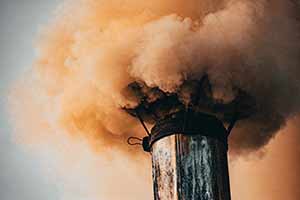
Dear EarthTalk: Is there any overlap between the #BlackLivesMatter and Environmental Justice movements? — Jennifer B., Athens, GA
There certainly is. “Environmental injustice” — defined as the unfair siting of pollution and other environmental ills in proximity to certain groups based on race or income status — is on a list of 12 issues Black Lives Matter (BLM) considers pressing right now as part of its #WhatMatters2020 campaign.
“Environmental racism kills. Air pollution and rollbacks to environmental protections and regulations make it hard for black people to breathe,” says Robert Bullard of the non-profit National Black Environmental Justice Network.
Sammy Roth reports in the Los Angeles Times that there are many links between ecological degradation and inequality: “Consider water contamination in predominantly black and brown communities, such as Flint, Michigan, where experts say the drinking water crisis was rooted in systemic racism.” She cites a February 2020 Los Angeles Times investigation that found Black, Latino and low-income California residents to be especially likely to live near polluting unplugged oil and gas wells. And many studies show that people of color are more likely than whites to live near power plants, oil refineries and landfills. “In the U.S., the best predictor of whether you live near a hazardous waste site is the color of your skin.”
To add insult to injury, climate change is already hitting people of color harder than others in the U.S., a fact not lost on BLM. “We are not saying that white people do not feel the impact of climate change,” BLM activists Patrisse Cullors and Nyeusi Nguvu report in a Guardian op-ed. “We are saying that if you are black then you are more likely to die as a result of it — and, if you survive, are more likely to struggle to replace what was lost and will receive little support in doing so.”
What can we do to reduce or eliminate this insidious form of injustice? Activists blame governments as well as corporations for discriminating against racial minorities in deciding where to put pollution sources. Attending local zoning or planning board meetings in your city or town — and speaking up against what’s not right — would be a good start. But, of course, there is more to the story.
“While it is clear that discriminatory siting plays a role, other causes may help explain both the behavior of firms and the disparate environmental harms experienced by low-income populations and minorities,” reports Shea Diaz in the Vermont Journal of Environmental Law. “Regulators may enforce environmental laws and regulations unequally, affected communities may lack political power, and market dynamics may drive both businesses and residents to low-cost real estate.”
According to Diaz, it’s important to understand the contribution of each of these to environmental injustice, because they may call for different policy responses. And only when a majority of elected officials agree can we begin to enact laws that regulate how governments and companies treat minority and low-income communities.
Contacts: #WhatMatters2020, blacklivesmatter.com/what-matters-2020/; “The toxic legacy of old oil wells,” latimes.com/projects/california-oil-well-drilling-idle-cleanup/; As Rising Heat Bakes U.S. Cities, The Poor Often Feel It Most, www.npr.org/2019/09/03/754044732/as-rising-heat-bakes-u-s-cities-the-poor-often-feel-it-most; “Getting to the root of Environmental Injustice,” vjel.vermontlaw.edu/getting-to-the-root-of-environmental-injustice/; National Black Environmental Justice Network, nbejn.com

Dear EarthTalk: Can you explain the concept of “Material Ecology” as advertised in a new Museum of Modern Art exhibit? — Nancy R., New York, NY
Israeli-born designer and architect Neri Oxman, founding director of the Mediated Matter Group at the Massachusetts Institute of Technology’s Media Lab, coined the term Material Ecology to describe a process of combining materials science, digital fabrication technologies and organic design to produce techniques and objects informed by the structural, systemic and aesthetic wisdom of nature.
Oxman’s vision involves harnessing biological impulses to grow and build in the pursuit of developing structures out of natural elements alongside man-made designs and parts. “It is the definition of ecology — the branch in biology that deals with the relations between organisms and their physical surroundings—applied to all things man-made or human-designed,” she tells Dezeen. “Biology is far more refined and sophisticated than material practices involved in polymers, concrete, steel and glass,” she adds. “But what if we could change that by creating new technologies that can vary the physical properties of matter at a resolution and sophistication that approaches that of the natural world?”
The best-known example of Oxman’s work to date is the so-called Silk Pavilion, first conceived at MIT in 2013, whereby 6,500 silkworms were fed and released onto a human-designed, robot-created cocoon-like dome structure, eventually completing the human/natural architecture by weaving a silk cover.
Animal rights activists might at first be alarmed at the concept of enslaving silkworms to make use of their biological product for human benefit, but taking a wider view of the situation affords a more humane conclusion. Oxman points out that the traditional process of harvesting silk (“sericulture”) kills silkworm larva, effectively sacrificing the next generation of silkworms for the sake of producing silk.
“In the textile and silk industry today, silkworms are exterminated while in their cocoon, dissolving the adhesive that glues one strand of silk to the layers below,” reports Oxman. “This process allows a single silk strand to be unrolled from the cocoon, but disrupts the life cycle and development of the organism.”
But in creating the silk cover for the pavilion, the silkworms’ product ends up in use as strands in the structure’s cover instead of as the walls of a cocoon; no silkworms-to-be are harmed.
Oxman hopes her work can highlight that, with creative thinking, we can overcome the limitations of “additive manufacturing” (e.g., 3D printing) at architectural scales. Currently the small size of 3D printers restricts the usefulness in real-world applications for this emerging technology. Putting 3D printers on huge robotic arms and combining the technology with natural forms of building (like the silkworm’s silk) could revolutionize how we build. “In the future, we will not build our products and our architecture; rather we will grow them,” Oxman predicts. “But it will take a village, not a lab.”
The Museum of Modern Art’s virtual exhibit “Neri Oxman: Material Ecology” ended on May 25.
Contacts: Neri Oxman, neri.media.mit.edu; “Silkworms and robot work together to weave Silk Pavilion,” dezeen.com/2013/06/03/silkworms-and-robot-work-together-to-weave-silk-pavilion.

Dear EarthTalk: Is it true that the Trump administration is using the cover of the COVID-19 crisis to roll back environmental health standards? — J.K. Miami, FL
Environmental advocates and others who care about clean air and water certainly seem to think the Trump administration has been taking advantage of the distractions of the Coronavirus pandemic and #BlackLivesMatter unrest to scale back environmental rules for the benefit of corporate interests and at the expense of public health.
The Trump administration has been hacking away at environmental rules ever since it took office in 2017. But the recent round of rollbacks started in earnest in late March 2020 — just as COVID-19 began to dominate news cycles — when the White House quietly replaced Obama-era fuel economy standards for cars and trucks with weaker ones that allow for more air pollution, froze standards for fine particulates (soot) despite research that a slight bump in regulations could save tens of thousands of lives annually, and eased up on restrictions on the kinds of effluents polluters can release into streams and wetlands.
Adding insult to injury, in early June President Trump issued an executive order waiving parts of the National Environmental Policy Act — the nation’s 50-year-old cornerstone environmental law — to spur the construction of highways, pipelines and other infrastructure projects. Meanwhile, the administration has doubled down on efforts to expand logging and oil drilling in Alaska while proposing to speed up permitting for off-shore fish farms, drop review requirements for liquefied natural gas terminals, and relax mercury pollution standards for power plants. The icing on the cake is that Trump wants to pillage ecosystems beyond our own planet, with a new proposal to mine the moon.
Environmental leaders are crying foul that such moves aren’t only illegal but also put public and environmental health at risk — all while the nation is distracted by COVID-19 and racial turbulence.
“People right now are hunkered down trying to put food on the table, take care of people who are sick and worry about educating their children at home,” said former Environmental Protection Agency chief (under Barack Obama) Gina McCarthy to the Guardian. McCarthy is now head of the Natural Resources Defense Council (NRDC). McCarthy added that the federal government is “literally not interested in the law or science [which] is going to become strikingly clear as people look at how the administration is handling Covid-19.”
Environmentalists are also keeping their fingers crossed that Joe Biden becomes President in 2021 and can roll back the rollbacks. In the meantime, if you would like your voice to be heard, NRDC has made it easy to send comments via its website urging Trump and current EPA Administrator Andrew Wheeler to maintain limits on industrial pollution and keep clean car standards on the books.
Contacts: “Trump, Citing Pandemic, Moves to Weaken Two Key Environmental Protections,” www.nytimes.com/2020/06/04/climate/trump-environment-coronavirus.html; “Trump to roll back Obama-era clean car rules in huge blow to climate fight,” www.theguardian.com/environment/2020/mar/31/trump-epa-obama-clean-car-rules-climate-change; “Trump administration declines to stiffen US clean air standards,” www.theguardian.com/environment/2020/apr/14/trump-epa-soot-pollution-clean-air-standards; NRDC’s “Don’t Let Trump Use the COVID-19 Crisis to Roll Back Public Health Protections,” https://act.nrdc.org/letter/4839-public-health-rollbacks-200401.









